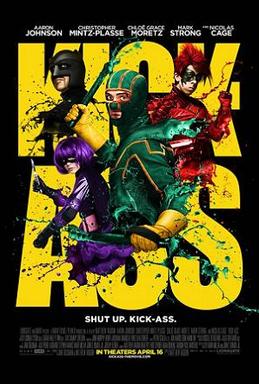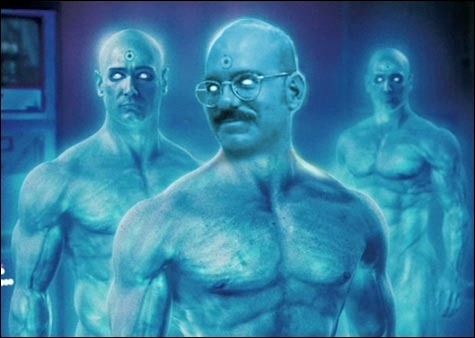Kudos to whoever came up with the paint spatter motif for the posters.
Staying true to the trend set by Watchmen, Kick-Ass is ridiculously violent, but unlike that other masked vigilante movie, there is a deeper meaning to the uncompromising blood-shed; it essentially allows the movie to function as a sort of cautionary tale. It answers the main character's question "Why has nobody tried to be a superhero before?" People do not dress and fight crime because they would be beaten, shot at and gutted. Even more importantly, the vigilante would be forced to inflict the same death sentences on his prey. It is Batman's no-kill rule that allows him to remain appealing despite the brutal nature of his justice. It's also the most fantastic aspect about his character. Kick-Ass essentially calls bullshit on Batman, and shows people just how bloody being a superhero would be.At the same time, Kick-Ass pushes the boundaries of aestheticized violence and popular taste. There are two brilliantly choreographed fight scenes in the same vein as The Matrix's seminal lobby shoot out that convincingly present mass murder as something balletic and beautiful. The hook is, both of these massacres, and another intense first-person-shooting scene, are performed by an 11 year-old-girl, acted by a 13 year-old-actress. Hit-Girl is the boldest, most horrifying incarnation of the Child Soldier archetype I have yet to encounter, and yet I couldn't help but cheer as she butchered drug dealers and scum bags with ropes, knifes, guns and swords. Her attacks were simply too creative, and too cleanly executed to not admire, especially when her skills are contrasted against the bumbling titular hero, who spends most of his time in-costume getting beaten up.
There she is, Big Daddy's little murderer.
Even more unsettling than Hit-Girl's actual fight scenes are her training scenes. In what might be his best role since Matchstick Men, Nicholas Cage plays a profoundly disturbed Ex-Cop turned costumed vigilante dubbed Big Daddy; think Batman with guns and a murderous daughter instead of Robin. He buys her daughter butterfly knives for her birthday, drills her on her crime-related factoids, and trains her how to take a gunshot with a bullet-proof vest. Even though the movie has the decency to point out the truly sick nature of his revenge scheme, the outcome of the story seems to condone his heinous training, leaving a truly immoral aftertaste in the brain.
At the same time, there is more to the movie's message. Dave Lizewski is a truly likable main character, and his super-heroic coming of ages covers topical bases like becoming an Internet celebrity and trying to woo a girl despite rumors of being gay. The movie also lambastes a number of familiar superhero tropes, like rescuing lost cats and talking like a pompous douchebag. The catch is, the ugly, unfunny violence is as much a part of the social commentary and as the simple laughs.
I haven't read the Kick-Ass comics yet, but after watching the movie I fully intend to. I've found that comics are often a more comfortable medium for digesting violence than film, though I understand that they are every bit as violent as the film.
The tag-line is certainly accurate as far as the movie is concerned.
If you are a fan of Superhero flicks, consider Kick-Ass required viewing. Don't take Grandma or the parents though. They may find the violence hard to swallow. Hell, you might too.








